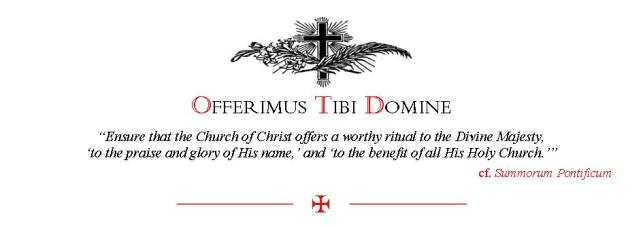
Fr Ray Blake has drawn attention to the ever wise words of Bishop Athanasius Schnieder. I had the privilege of meeting Bishop Schnieder last year - a wonderful, holy man with a twinkle in his eye, who pulls no punches! Fr Blake has has listed the themes from the Bishop's recent speech - Six Principles of Liturgical Reform - but the whole is well worth reading. Most especially as Fr Blake draws out the direct link in the Bishop's talk to the principles enshrined in - guess where - the documents of the Second Vatican Council, in this case, Sacrosanctum Concilium. Yet another example of an authentic interpretation of what is actually written in the documents of the Council which we find, on mature reflection, is in direct opposition to the havoc that has been wreaked in it's name.
I'd like to draw attention to each one individually with its own post, so here is the first. Great stuff!
I'd like to draw attention to each one individually with its own post, so here is the first. Great stuff!
I –Turning our gaze towards Christ
In order to speak of new evangelization correctly, it is necessary first to turn our gaze towards Him Who is the true evangelizer, namely Our Lord and Saviour Jesus-Christ, the Word of God made Man. The Son of God came upon this earth to expiate and redeem the greatest sin, sin par excellence. And this sin, humanity's sin par excellence, consists in refusing to adore God, in refusing to keep the first place, the place of honor, for Him. This sin on the part of man consists in not paying attention to God, in no longer having a sense of the fittingness of things, or even a sense of the details pertaining to God and to the Adoration that is His due, in not wanting to see God, in not wanting to kneel before God.
For such an attitude, the incarnation of God is an embarrassment; as a result the real presence of God in the Eucharistic mystery is likewise an embarrassment; the centrality of the Eucharistic presence of God in our churches is an embarrassment. Indeed sinful man wants the center stage for himself, whether within the Church or during the Eucharistic celebration; he wants to be seen, to be noticed.
For this reason Jesus the Eucharist, God incarnate, present in the tabernacle under the Eucharistic form, is set aside. Even the representation of the Crucified One on the cross in the middle of the altar during the celebration facing the people is an embarrassment, for it might eclipse the priest's face. Therefore the image of the Crucified One in the center of the altar as well as Jesus the Eucharist in the tabernacle, also in the center of the altar, are an embarrassment. Consequently, the cross and the tabernacle are moved to the side. During mass, the congregation must be able to see the priest’s face at all times, and he delights in placing himself literally at the center of the house of God. And if perchance Jesus the Eucharist is still left in His tabernacle in the middle of the altar because the Ministry of Historical Monuments—even in an atheist regime—has forbidden moving it for the conservation of artistic heritage, the priest, often throughout the entire Eucharistic celebration, does not scruple to turn his back to Him.
How often have good and faithful adorers of Christ cried out in their simplicity and humility : “God bless you, Ministry of Historical Monuments ! At least you have left us Jesus in the center of our church.”











No comments:
Post a Comment